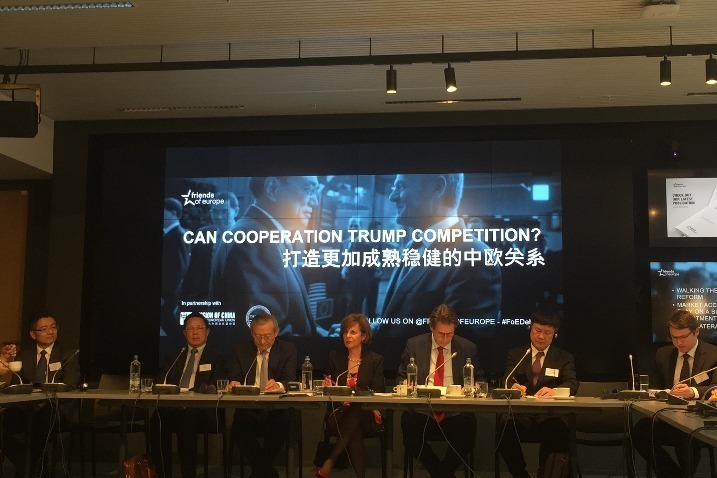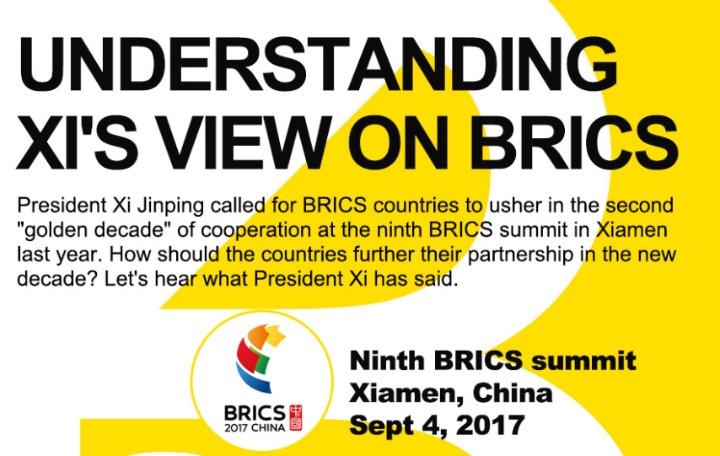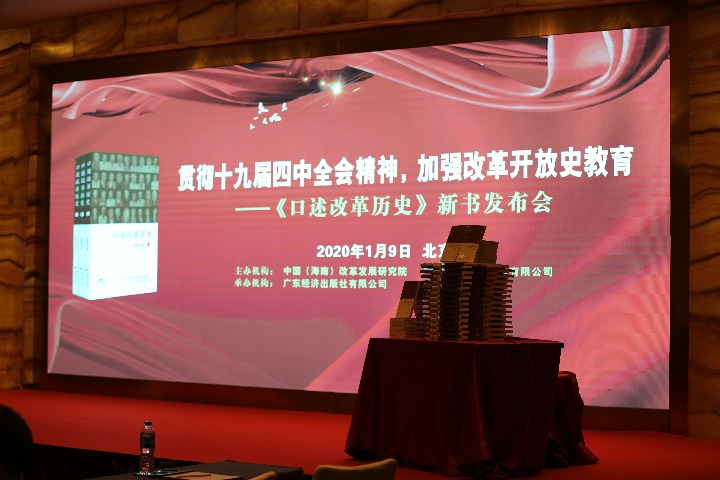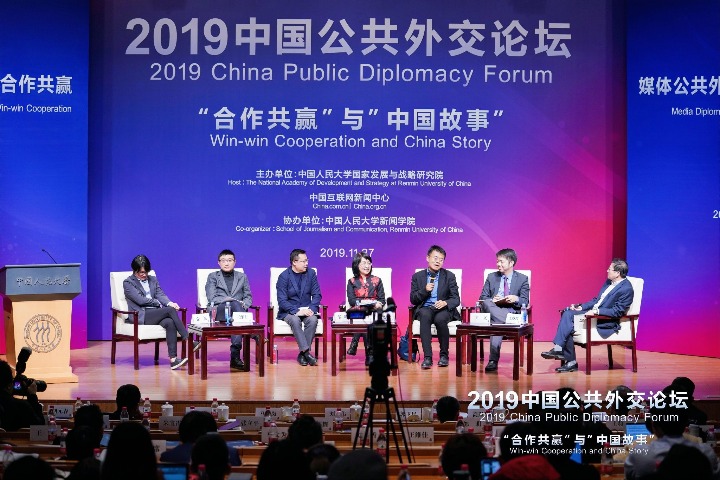40 years of working with an opening China
By YOHEI SASAKAWA |
chinawatch.cn |
Updated: 2019-04-24 13:49
The Nippon Foundation, of which I serve as chairman, and its affiliated organizations, began working with China in the early 1980s, initially on efforts to eliminate leprosy in the country. At that time, China was introducing measures to reform and open the country to the outside world and embark on a path of economic development. On the streets of major cities like Beijing, Shanghai or Guangzhou, people wore monotone clothing of dark blue, grey or green, and walking down the street felt like being in a black-and-white television scene.
Over the ensuing years, we have worked with many people in various fields in both Japan and China, primarily in the areas of personnel exchanges and human resource development. We implemented more than 500 projects involving exchanges between Japan and China, directly involving about 50,000 people in the two countries. During this time, the black-and-white scene gradually acquired color, and today China outshines Japan as a country that produces some of the world’s most colorful images. Our overarching goal has been that the people of both Japan and China enjoy peace and prosperity, and as I have devoted myself to these exchange programs, I have been a witness to China’s astounding growth and development, which are unparalleled in human history.
When I visited China with my father, Ryoichi Sasakawa, in the 1980s, we met several times with Deng Xiaoping, the chief architect of China's economic reforms and China's socialist modernization. I can still clearly remember Deng saying: “Reform and opening are the only path China can take to survive.” I also remember when this program faced a period of difficulty; Mr Deng, although retired, made his famous “southern tour” with Yang Shangkun (president of the of China from 1988 to 1993) through cities in south China to shore up support for the national policy of reform and opening-up.
When China was subject to international economic sanctions, . Shangkun asked me to see how Japan, the country most familiar with China, could help lift the sanctions. Through the efforts of Noboru Takeshita, a former prime minister, Japan lifted its economic sanctions and immediately resumed its third yen loan, providing 760 billion yen that proved to be a catalyst for China’s economic development. This was very meaningful for me.
Yangmingism, a school of neo-Confucianism based on the teachings of Wang Yangming that had its origins in China’s Ming Dynasty (1368–1644), was brought to Japan by its followers who fled China after the fall of the dynasty, and had a major effect on Japanese society. Yangmingism espouses the doctrine of “unity of knowing and acting,” meaning that knowledge and action are one and the same and cannot be separated; or in other words, if one does not act, one does not have knowledge. I believe the Chinese are truly the world’s greatest practitioners of the unity of knowing and acting.
Around the world, there are many national government projects that are presented as a distillation of the wisdom of the country’s top leaders, but there are few examples that match the knowledge and strength of action seen in the Chinese people’s determination to implement individual projects. The Pudong Development Plan is a good example. When I visited China in 1990, the year the plan was proposed, a Shanghai government official showed me around Pudong and explained the plan, using a model of the project and pointing to fields as far as the eye could see.
The first briefing on the Pudong Development Plan in Japan was held the same year, when a delegation of city officials from China’s coastal regions, led by Huang Ju, were invited to Japan. The next year, when I accompanied Huang, who by then was mayor of Shangahi, on a tour of the major construction project for the Kansai International Airport, he told me how impressed he was by the project. However, the Pudong Development Plan went far beyond our imagination, and it was the Chinese who were able to follow through with that transformation.
Twenty years later, that plan on paper became the wonder that is the Pudong New Area, which is admired around the world.
The Nippon Foundation and its affiliated organizations have implemented a variety of programs to meet China’s needs at various stages of reform and opening-up, reorienting our direction as necessary along the way. From the late 1980s, we first worked to initiate and expand reciprocal personal visits between Japan and China, and in the early 1990s we supported economic transformation, including sharing our experience with privatizing State-owned companies. We also conducted numerous programs that brought officials from the central government as well as specialists who would be carrying out regulatory reform in rural areas to Japan.
Having worked together with the Chinese during 40 years of reform and opening-up, we admire China’s abundant, high-quality human resources. I am convinced that human resources are the most important driving force supporting peace and development in China, Asia, and the world, and the Nippon Foundation and our affiliated organizations have engaged in many joint projects with China, with a focus on human resource development. The Sasakawa Medical Fellowship has awarded with the cooperation of China's National Health Commission and has trained more than 2,300 medical students in various fields, most of whom have gone on to become leaders in the field of health and medicine in China, as academicians of the Chinese Academy of Sciences,or heads of hospitals or medical schools in China. A scholarship recipient also directed the emergency response to the 2008 Sichuan earthquake.
Another good example is the Ryoichi Sasakawa Young Leaders Fellowship Fund, a program that five major universities in China joined in 1992 and an additional five in 1994. This program provides scholarships for graduate students pursuing degrees in the humanities at 69 universities in 44 countries, and has provided scholarships to more than 16,000 students around the world, of whom roughly 8,000, or half, are from these 10 Chinese universities. Many of these students are now heads of universities, senior corporate managers, key government officials and judges. In these positions, they have been active in supporting China’s reform and opening-up and will continue to contribute to China’s social development.
We have also been engaged in human resource development in China in countless other ways, including a human resource training program in international relations at Peking University that has been going on for more than 20 years, Japanese language training across China, the training of technicians in the field of high-speed rail transport, and the donation of a total of 4 million books and publications to more than 70 universities in China.
Japan and China are geopolitically inseparable. The economic relationship is already mutually complementary; the Japanese cannot go about their daily lives without food and other products from China, and the same is becoming true in China with regard to goods from Japan.
I am convinced that a healthy relationship will be maintained between the two countries for the next 40 years as well through continued efforts by the people of both countries to know each other better as tourism and other forms of exchanges become more popular. Japan does have major problems, but this also means that Japan has been dealing for some time with issues that China is now beginning to face, including environmental issues, a declining birthrate and aging population, and regional revitalization, and so Japan's experience and expertise will help China address these issues.
The author is chairman of the Nippon Foundation.
The author contributed this article to China Watch exclusively. The views expressed do not necessarily reflect those of China Watch.
All rights reserved. Copying or sharing of any content for other than personal use is prohibited without prior written permission.
The Nippon Foundation, of which I serve as chairman, and its affiliated organizations, began working with China in the early 1980s, initially on efforts to eliminate leprosy in the country. At that time, China was introducing measures to reform and open the country to the outside world and embark on a path of economic development. On the streets of major cities like Beijing, Shanghai or Guangzhou, people wore monotone clothing of dark blue, grey or green, and walking down the street felt like being in a black-and-white television scene.
Over the ensuing years, we have worked with many people in various fields in both Japan and China, primarily in the areas of personnel exchanges and human resource development. We implemented more than 500 projects involving exchanges between Japan and China, directly involving about 50,000 people in the two countries. During this time, the black-and-white scene gradually acquired color, and today China outshines Japan as a country that produces some of the world’s most colorful images. Our overarching goal has been that the people of both Japan and China enjoy peace and prosperity, and as I have devoted myself to these exchange programs, I have been a witness to China’s astounding growth and development, which are unparalleled in human history.
When I visited China with my father, Ryoichi Sasakawa, in the 1980s, we met several times with Deng Xiaoping, the chief architect of China's economic reforms and China's socialist modernization. I can still clearly remember Deng saying: “Reform and opening are the only path China can take to survive.” I also remember when this program faced a period of difficulty; Mr Deng, although retired, made his famous “southern tour” with Yang Shangkun (president of the of China from 1988 to 1993) through cities in south China to shore up support for the national policy of reform and opening-up.
When China was subject to international economic sanctions, . Shangkun asked me to see how Japan, the country most familiar with China, could help lift the sanctions. Through the efforts of Noboru Takeshita, a former prime minister, Japan lifted its economic sanctions and immediately resumed its third yen loan, providing 760 billion yen that proved to be a catalyst for China’s economic development. This was very meaningful for me.
Yangmingism, a school of neo-Confucianism based on the teachings of Wang Yangming that had its origins in China’s Ming Dynasty (1368–1644), was brought to Japan by its followers who fled China after the fall of the dynasty, and had a major effect on Japanese society. Yangmingism espouses the doctrine of “unity of knowing and acting,” meaning that knowledge and action are one and the same and cannot be separated; or in other words, if one does not act, one does not have knowledge. I believe the Chinese are truly the world’s greatest practitioners of the unity of knowing and acting.
Around the world, there are many national government projects that are presented as a distillation of the wisdom of the country’s top leaders, but there are few examples that match the knowledge and strength of action seen in the Chinese people’s determination to implement individual projects. The Pudong Development Plan is a good example. When I visited China in 1990, the year the plan was proposed, a Shanghai government official showed me around Pudong and explained the plan, using a model of the project and pointing to fields as far as the eye could see.
The first briefing on the Pudong Development Plan in Japan was held the same year, when a delegation of city officials from China’s coastal regions, led by Huang Ju, were invited to Japan. The next year, when I accompanied Huang, who by then was mayor of Shangahi, on a tour of the major construction project for the Kansai International Airport, he told me how impressed he was by the project. However, the Pudong Development Plan went far beyond our imagination, and it was the Chinese who were able to follow through with that transformation.
Twenty years later, that plan on paper became the wonder that is the Pudong New Area, which is admired around the world.
The Nippon Foundation and its affiliated organizations have implemented a variety of programs to meet China’s needs at various stages of reform and opening-up, reorienting our direction as necessary along the way. From the late 1980s, we first worked to initiate and expand reciprocal personal visits between Japan and China, and in the early 1990s we supported economic transformation, including sharing our experience with privatizing State-owned companies. We also conducted numerous programs that brought officials from the central government as well as specialists who would be carrying out regulatory reform in rural areas to Japan.
Having worked together with the Chinese during 40 years of reform and opening-up, we admire China’s abundant, high-quality human resources. I am convinced that human resources are the most important driving force supporting peace and development in China, Asia, and the world, and the Nippon Foundation and our affiliated organizations have engaged in many joint projects with China, with a focus on human resource development. The Sasakawa Medical Fellowship has awarded with the cooperation of China's National Health Commission and has trained more than 2,300 medical students in various fields, most of whom have gone on to become leaders in the field of health and medicine in China, as academicians of the Chinese Academy of Sciences,or heads of hospitals or medical schools in China. A scholarship recipient also directed the emergency response to the 2008 Sichuan earthquake.
Another good example is the Ryoichi Sasakawa Young Leaders Fellowship Fund, a program that five major universities in China joined in 1992 and an additional five in 1994. This program provides scholarships for graduate students pursuing degrees in the humanities at 69 universities in 44 countries, and has provided scholarships to more than 16,000 students around the world, of whom roughly 8,000, or half, are from these 10 Chinese universities. Many of these students are now heads of universities, senior corporate managers, key government officials and judges. In these positions, they have been active in supporting China’s reform and opening-up and will continue to contribute to China’s social development.
We have also been engaged in human resource development in China in countless other ways, including a human resource training program in international relations at Peking University that has been going on for more than 20 years, Japanese language training across China, the training of technicians in the field of high-speed rail transport, and the donation of a total of 4 million books and publications to more than 70 universities in China.
Japan and China are geopolitically inseparable. The economic relationship is already mutually complementary; the Japanese cannot go about their daily lives without food and other products from China, and the same is becoming true in China with regard to goods from Japan.
I am convinced that a healthy relationship will be maintained between the two countries for the next 40 years as well through continued efforts by the people of both countries to know each other better as tourism and other forms of exchanges become more popular. Japan does have major problems, but this also means that Japan has been dealing for some time with issues that China is now beginning to face, including environmental issues, a declining birthrate and aging population, and regional revitalization, and so Japan's experience and expertise will help China address these issues.
The author is chairman of the Nippon Foundation.
The author contributed this article to China Watch exclusively. The views expressed do not necessarily reflect those of China Watch.
All rights reserved. Copying or sharing of any content for other than personal use is prohibited without prior written permission.









